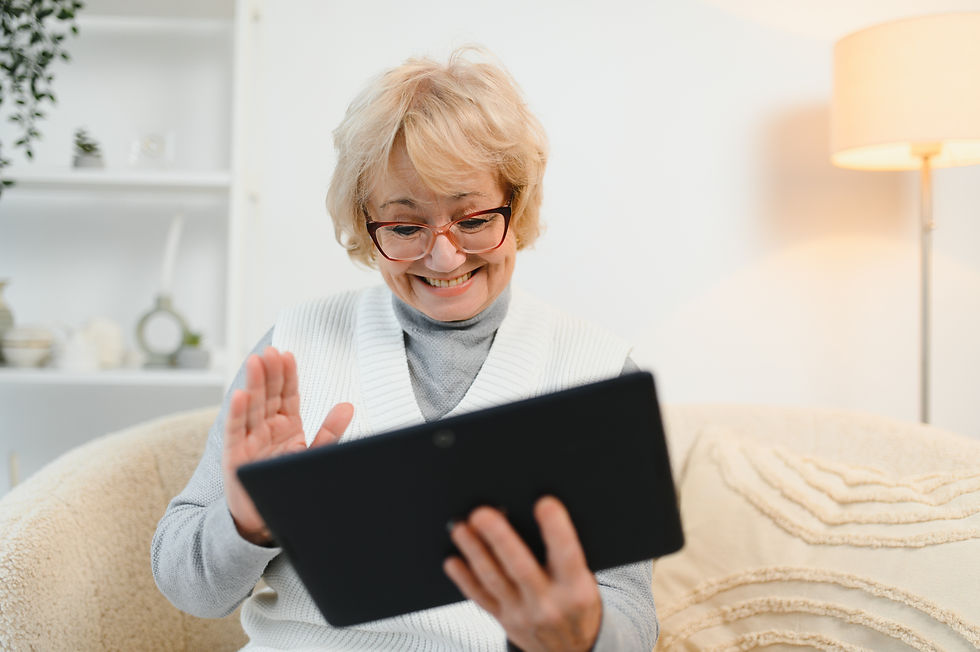Bridging the care gap: how telephysiotherapy is transforming mobility and falls prevention in aged care
- Institute for Musculoskeletal Health
- Jul 24
- 3 min read
Updated: Sep 23

Falls and mobility issues are among the most pressing concerns for older Australians receiving aged care—both at home and in residential facilities. While physiotherapist-led exercise programs have long been proven to help, limited access to these services remains a barrier. Now, an innovative telehealth solution is stepping in to fill that gap.
The TOP-UP trial, led by Dr Rik Dawson and recently published in the Medical Journal of Australia, introduces a groundbreaking telephysiotherapy intervention designed to improve mobility, reduce fall risk, and enhance quality of life for older people in aged care. And the results are promising.
What we know: exercise helps - but access is the issue
Tailored balance and strength exercises are proven to reduce falls and maintain independence in older people. Trials like Australia’s 2018 SUNBEAM study demonstrated that moderate-intensity exercise, when guided by a physiotherapist, can improve mobility and reduce fall rates in aged care populations.
However, widespread implementation is limited. A shortage of physiotherapists, especially in regional areas, combined with staffing pressures, means many older Australians don’t receive the exercise support they need.
The new approach: TOP-UP (Telephysiotherapy for Older People)
TOP-UP is a co-designed telephysiotherapy program that combines:
Virtual physiotherapy assessments via Zoom
Tailored exercise videos
Support from aged care workers
Goal-oriented tracking and feedback
Delivered over six months, the program encourages participants to complete two hours of moderate-intensity balance and strength exercises weekly, using resources like the Otago Exercise Program. Aged care workers helped support and supervise sessions, making it accessible to people with cognitive impairment or mobility limitations.
"As a physiotherapist, I see a lot of older patients who’ve gradually lost strength and mobility over time who are scared to get back into regular exercise in case they fall and hurt themselves. But over 6 months, this program helped people to walk better and fall less,” said Dr Dawson.
The results: measurable gains across the board
Involving 242 aged care recipients aged 65+ across New South Wales, Victoria, and Western Australia, the TOP-UP trial compared outcomes between participants receiving the program and a control group receiving usual care.
Here’s what they found after six months:
Mobility improved significantly: Participants in the TOP-UP group gained an average of 2.1 points on the Short Physical Performance Battery (SPPB)—exceeding the clinically meaningful improvement threshold.
Fall risk reduced: Fewer participants had falls (38% reduction).
Pain reduced: 1.1 points lower on the 10-point pain scale used as standard in healthcare (with 1 being no pain and 10 being the worst pain imaginable).
Function improved: Better sit-to-stand performance, balance, and gait speed.
Quality of life improved: Participants reported a significant improvement in perceived quality of life (6 points on a 100 point scale).
More than 90% would recommend the program to others.
Why This Matters
The TOP-UP model shows that with the right design, telehealth can deliver real-world benefits to aged care residents—even those with cognitive impairment or limited prior tech experience.
In a sector facing workforce shortages and increasing demand, telephysiotherapy could help bridge critical service gaps. The program achieved high adherence and engagement, with aged care workers playing a crucial support role—demonstrating how collaboration can amplify care impact.
“One of the great things shown in the data from the TOP UP trial was that this combination of expert advice from physiotherapists over video consultations such as Zoom and in-person support from care workers or family meant we could provide a safe, accessible environment for people to exercise more, improve mobility and regain some of their independence," Prof Cathie Sherrington.
What’s Next?
While results were strong, researchers note that sustained benefits require ongoing exercise beyond the six-month period. Future expansion of telephysiotherapy programs will need to address:
Long-term program sustainability
Digital literacy barriers
Technology access and training
Workforce capacity in aged care
Still, the message is clear: when in-person physiotherapy isn’t feasible, telephysiotherapy is a safe, effective, and scalable solution.
Final Takeaway
The TOP-UP trial offers hope and evidence for a smarter, more inclusive future in aged care. By embracing telehealth and building local support into care delivery, we can help older Australians stay mobile, independent, and confident—no matter where they live.
This research was supported by Dementia Australia, and Aged Care Research and Industry Innovation Australia.
Media enquiries: Matt Johnston (Media and PR Advisor at the University of Sydney) - matt.johnston@sydney.edu.au or +61 434 769 373.
Dawson R, et al. (2025). The Telephysiotherapy for Older People (TOP-UP) program for enhancing mobility in folks receiving aged care: a hybrid kind 1 effectiveness-implementation randomised managed trial, Medical Journal of Australia. DOI: 10.5694/mja2.70004
Written by Courtney West, Dr Rik Dawson and Prof Cathie Sherrington.


